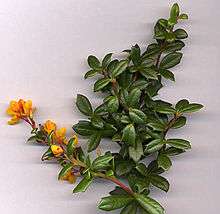Berberis darwinii
| Berberis darwinii | |
|---|---|
 | |
| Foliage and flowers | |
| Scientific classification | |
| Kingdom: | Plantae |
| (unranked): | Angiosperms |
| (unranked): | Eudicots |
| Order: | Ranunculales |
| Family: | Berberidaceae |
| Genus: | Berberis |
| Species: | B. darwinii |
| Binomial name | |
| Berberis darwinii Hook. | |
| Synonyms[1][2] | |
| |
Berberis darwinii is a species of barberry in the family Berberidaceae,[3] native to southern Chile and Argentina and naturalized elsewhere. English common names include 'Darwin's Barberry'. Vernacular names include michay, calafate, and quelung.[4]
It is an evergreen thorny shrub growing to 3–4 m tall, with dense branches from ground level. The leaves are small oval, 12–25 mm long and 5–12 mm broad, with a spiny margin; they are borne in clusters of 2–5 together, subtended by a three-branched spine 2–4 mm long. The flowers are orange, 4–5 mm long, produced in dense racemes 2–7 cm long in spring. The fruit is a small purple-black berry 4–7 mm diameter, ripening in summer.
B. darwinii was discovered (in Western science) in South America in 1835 by Charles Darwin during the voyage of the 'Beagle'; however, the berries of this species were consumed by prehistoric native peoples[5] in the Patagonian region over millennia. The species was one of many named in honour of Darwin.[6]
It is a popular garden and hedging shrub in the British Isles. The Royal Horticultural Society has given the species its Award of Garden Merit.[7] The edible fruit is very acidic.
B. darwinii is regarded as an invasive plant pest in New Zealand[8] that escaped from gardens into indigenous plant communities via its bird-dispersed seeds.[9] It is considered a serious threat to indigenous ecosystems throughout New Zealand[10] and is listed on the National Pest Plant Accord. In Australia, the species is naturalised in the states of South Australia, Victoria, New South Wales and Tasmania.[11] The species has also become sparingly naturalized in the US states of California and Oregon.[12]
See also
| Wikimedia Commons has media related to Berberis darwinii. |
References
- ↑ "Tropicos - Name - Berberis darwinii Hook.".
- ↑ "Berberis darwinii Hook. — The Plant List".
- ↑ Chilebosque: Berberis darwinii Retrieved Aug. 2008
- ↑ Berberis darwinii at Flora Chilena (Spanish)
- ↑ C.Michael Hogan (2008) Cueva del Milodon, The Megalithic Portal, ed. A. Burnham
- ↑ New York Academy of Sciences, Annals of the New York Academy of Sciences, Published by The Academy, 1909
- ↑ "Berberis darwinii".
- ↑ Darwin's barberry Archived October 14, 2008, at the Wayback Machine., Containment pest plants, Greater Wellington Regional Council website, retrieved 12 January 2009.
- ↑ Darwin’s barberry, DOC's weed work, Department of Conservation website, retrieved 4 January 2011.
- ↑ Seedling Recruitment of the Invasive Species Berberis Darwinii (Darwin's Barberry): What Contributes to Invasion Success?, McAlpine, Katherine (Kate) Grace, 2005, Victoria University of Wellington doctoral thesis, retrieved 12 January 2009.
- ↑ "Berberis darwinii". Australian Plant Name Index (APNI), IBIS database. Centre for Plant Biodiversity Research, Australian Government, Canberra. Retrieved 20 March 2012.
- ↑ "Berberis darwinii in Flora of North America". efloras.org.